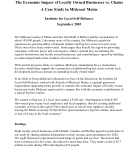Since the 1980s, Wal-Mart has received at least $150 million in local, state, and federal subsidies to build 47 distribution centers in 32 states, according to a study by The Palm Beach Post.
Only those subsidies that have been quantified in published reports were counted. "That number likely grows by tens of millions when unquantified breaks, such as government bond financing for construction, and ongoing breaks, such as those given to businesses in enterprise zones, are included," the newspaper notes.
The Post only reviewed subsidies for distribution centers. It did not examine the hundreds of millions of dollars in tax breaks and incentives Wal-Mart has received for its retail stores.
Wal-Mart currently has 84 distribution centers in the U.S.. The retailer has been building new centers at a furious pace to support new stores and its expansion into groceries.
Wal-Mart generally expects to receive government assistance for new distribution facilities and sometimes plays neighboring towns against one another to get the best deals. The centers vary in size from about 400,000 square feet to well over 1 million. They employ anywhere from 150 to 1,000 people at wages of about $8-$10 an hour.
Among the biggest subsidies documented by the report: $17 million in state and local incentives for distribution center in Lewiston, Maine; a $9 million handout in Bartlesville, Oklahoma; and $8.9 million free land and tax credits provided in Macclenny, Florida.
Earlier this year, activists in Killingly, Connecticut, had to file a Freedom of Information Act request to make public the details of $46 million in state and local subsidies earmarked for a Wal-Mart distribution center. Public outcry led the Killingly zoning board to effectively kill the project by denying a request to rezone the property.
Such subsidies are rarely, if at all, made available to locally owned businesses and their distributors. This has given Wal-Mart an unfair advantage in the market. Moreover, there’s little to justify the subsidies from an economic development standpoint. While distribution centers may boost employment locally, these new jobs generally come at the expense of existing distribution jobs in the surrounding region. Dozens of supermarket distributors have gone out of business since Wal-Mart began selling groceries.
——
Reprint Policy: We generally allow articles to be reprinted for non-commercial purposes, provided you attribute the article to the New Rules Project, include our web address, and do not alter or edit it in any way. Please contact us for permission to reprint this or other articles.



